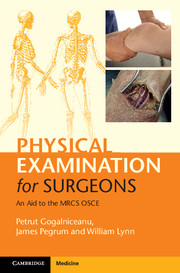Book contents
- Frontmatter
- Dedication
- Contents
- List of contributors
- Introduction
- Acknowledgments
- List of abbreviations
- Section 1 Principles of surgery
- Section 2 General surgery
- Section 3 Breast surgery
- Section 4 Pelvis and perineum
- Section 5 Orthopaedic surgery
- 14 Generic joint examination
- 15 Examination of gait
- 16 Examination of the cervical and thoracic spine
- 17 Cervical spine injury: assessment in trauma
- 18 Examination of the shoulder
- 19 Examination of the elbow
- 20 Examination of the lumbar spine and sacroiliac joint
- 21 Examination of the hip
- 22 Examination of the knee
- 23 Examination of the ankle
- Section 6 Vascular surgery
- Section 7 Heart and thorax
- Section 8 Head and neck surgery
- Section 9 Neurosurgery
- Section 10 Plastic surgery
- Section 11 Surgical radiology
- Section 12 Airway, trauma and critical care
- Index
22 - Examination of the knee
from Section 5 - Orthopaedic surgery
Published online by Cambridge University Press: 05 July 2015
- Frontmatter
- Dedication
- Contents
- List of contributors
- Introduction
- Acknowledgments
- List of abbreviations
- Section 1 Principles of surgery
- Section 2 General surgery
- Section 3 Breast surgery
- Section 4 Pelvis and perineum
- Section 5 Orthopaedic surgery
- 14 Generic joint examination
- 15 Examination of gait
- 16 Examination of the cervical and thoracic spine
- 17 Cervical spine injury: assessment in trauma
- 18 Examination of the shoulder
- 19 Examination of the elbow
- 20 Examination of the lumbar spine and sacroiliac joint
- 21 Examination of the hip
- 22 Examination of the knee
- 23 Examination of the ankle
- Section 6 Vascular surgery
- Section 7 Heart and thorax
- Section 8 Head and neck surgery
- Section 9 Neurosurgery
- Section 10 Plastic surgery
- Section 11 Surgical radiology
- Section 12 Airway, trauma and critical care
- Index
Summary
Checklist
WIPER
• Patient standing in shorts or underwear; hip and ankle joints exposed.
Physiological parameters
Gait
• Asymmetry of spine and pelvis
• Antalgic gait and walking aids
• Soles of footwear
Tape
• Quadriceps diameter: muscle bulk
Look
• Skin: scars, erythema, ecchymoses, sinuses, skin creases
• Soft tissues: wasting of quadriceps, swelling in popliteal fossa, knee effusion
• Bone:
• deformity or asymmetry
• pelvic tilt
• posterior subluxation of the tibia on the femur
• varus/valgus deformities of the knee
• flexion deformity or recurvatum
Feel
• Skin: temperature, tenderness
• Soft tissues:
• knee effusion and ‘ bulge ’ test
• patellar tap test
• popliteal fossa: Baker's cyst, popliteal artery aneurysm
• tendons: quadriceps tendon, patella tendon, pes anserinus, collateral ligaments and menisci, iliotibial band
• pulses, capillary refill, neurology
• Bone:
• tibial tuberosity and patella
• femur, tibia and joint line
• origin and insertion of collateral ligaments
Move
• Active:
• straight leg raise
• flexion and assess for crepitus
• extension against gravity
• Passive
• flexion
• hyperextension
• Resisted
• flexion
Special tests (* = essential tests)
• Patella: patella apprehension test,* patella tracking test, Clarke's test
• Collateral ligaments: valgus/varus pressure* (knee flexed at 30° flexion and extension)
• Menisci: McMurray's test*
• Cruciate ligaments: posterior sag test,* anterior & posterior drawer test,* Lachman's test,* pivot shift test, dial test
To complete the examination…
• Examine the joint above (hip joint) and the joint below (ankle joint).
• Check full neurovascular status of the lower limb.
• Order appropriate radiographs and further imaging.
Examination notes
How do you measure quadriceps diameter in order to assess wasting?
• Locate the tibial tuberosity. This is found on the proximal anterior tibia and demarcates the insertion of the patella tendon.
• Mark a point 20 cm proximal to this landmark, which is mid-thigh. (A longer measurement may be required in very tall individuals.)
- Type
- Chapter
- Information
- Physical Examination for SurgeonsAn Aid to the MRCS OSCE, pp. 175 - 189Publisher: Cambridge University PressPrint publication year: 2015

